
The Chair of St Augustine or Cathedra Augustini (Latin) is the ceremonial enthronement cathedra chair of the Archbishop of Canterbury in Canterbury Cathedral, Kent.

The Chair of St Augustine or Cathedra Augustini (Latin) is the ceremonial enthronement cathedra chair of the Archbishop of Canterbury in Canterbury Cathedral, Kent.
Named after the first Archbishop of Canterbury, St Augustine of Canterbury, the chair is made of Petworth marble. The current chair, documented in the Cathedral's accounts as made between 1201 and 1204, replaced one that was destroyed in the fire of 1174, however, its base may contain fragments of the original chair, which is mentioned in the descriptions of Eadmer and Gervase of Canterbury of the Anglo-Saxon and Romanesque buildings. [1] According to the cathedral the chair was once part of the furnishings of the shrine of St Thomas Becket, which was destroyed during the English Reformation. [2] The original chair was described by Eadmer as "the pontifical chair, constructed with handsome workmanship and of large stones and cement"; it stood in the western apse behind the altar of St Mary but perished in the fire of 1067. [3]
Since an early period, it has always had a place in the triple enthronement of an Archbishop of Canterbury. He is seated on the throne in the choir as Diocesan Bishop, in the chapter house as titular abbot, and in St. Augustine's chair as Primate of All England. This and the Lambeth Conference are the only occasions in which this cathedra is used. The choir throne is used for other occasions in which the archbishop is present.
Given the worldwide nature of the modern Anglican Communion, the enthronement in St Augustine's Chair has come to represent also the Archbishop of Canterbury's position as worldwide spiritual leader of the Communion; because of this it has become traditional following the enthronement in the Chair of St Augustine by the Dean of Canterbury [4] for the new archbishop to be blessed by the senior primatial archbishop (by length of service in office) from around the world; for example, Rowan Williams was blessed by the then archbishop of Armagh, Robin Eames, while Justin Welby was blessed by Archbishop of Burundi Bernard Ntahoturi, who gave his blessing in French. [5]

The archbishop of Canterbury is the senior bishop and a principal leader of the Church of England, the ceremonial head of the worldwide Anglican Communion and the bishop of the Diocese of Canterbury. The current archbishop is Justin Welby, who was enthroned at Canterbury Cathedral on 21 March 2013. Welby is the 105th person to hold the position, as part of a line of succession going back to the "Apostle to the English" Augustine of Canterbury, who was sent to the island by the church in Rome in 597. Welby succeeded Rowan Williams.

Canterbury Cathedral in Canterbury, Kent, is one of the oldest and most famous Christian structures in England. It forms part of a World Heritage Site. It is the cathedral of the Archbishop of Canterbury, currently Justin Welby, leader of the Church of England and symbolic leader of the worldwide Anglican Communion. Its formal title is the Cathedral and Metropolitical Church of Christ at Canterbury.
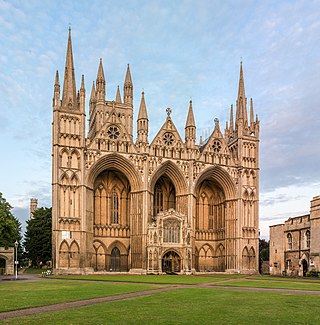
Peterborough Cathedral, properly the Cathedral Church of St Peter, St Paul and St Andrew – also known as Saint Peter's Cathedral in the United Kingdom – is the seat of the Anglican Bishop of Peterborough, dedicated to Saint Peter, Saint Paul and Saint Andrew, whose statues look down from the three high gables of the famous West Front. Although it was founded in the Anglo-Saxon period, its architecture is mainly Norman, following a rebuilding in the 12th century. With Durham and Ely cathedrals, it is one of the most important 12th-century buildings in England to have remained largely intact, despite extensions and restoration.

A papal coronation is the formal ceremony of the placing of the papal tiara on a newly elected pope. The first recorded papal coronation was of Pope Nicholas I in 858. The most recent was the 1963 coronation of Paul VI, who soon afterwards abandoned the practice of wearing the tiara. To date, none of his successors have used the tiara, and their papal inauguration celebrations have included no coronation ceremony, although any future pope may elect to restore the use of the tiara at any point during his pontificate.

Eadmer or Edmer was an English historian, theologian, and ecclesiastic. He is known for being a contemporary biographer of his archbishop and companion, Saint Anselm, in his Vita Anselmi, and for his Historia novorum in Anglia, which presents the public face of Anselm. Eadmer's history is written to support the primacy of Canterbury over York, a central concern for Anselm.

A throne is the seat of state of a potentate or dignitary, especially the seat occupied by a sovereign on state occasions; or the seat occupied by a pope or bishop on ceremonial occasions. "Throne" in an abstract sense can also refer to the monarchy or the Crown itself, an instance of metonymy, and is also used in many expressions such as "the power behind the throne".

Christ Church Cathedral, more formally The Cathedral of the Holy Trinity, is the cathedral of the United Dioceses of Dublin and Glendalough and the cathedral of the ecclesiastical province of the United Provinces of Dublin and Cashel in the (Anglican) Church of Ireland. It is situated in Dublin, Ireland, and is the elder of the capital city's two medieval cathedrals, the other being St Patrick's Cathedral.
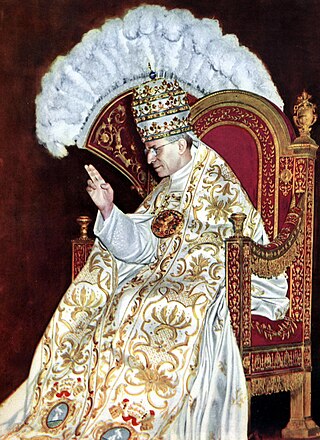
The sedia gestatoria or gestatorial chair is a ceremonial throne on which popes were carried on shoulders until 1978, which was later replaced outdoors in part with the popemobile. It consists of a richly adorned, silk-covered armchair, fastened on a suppedaneum, on each side of which are two gilded rings; through these rings pass the long rods with which twelve footmen (palafrenieri), in red uniforms, carry the throne on their shoulders. On prior occasions, as in the case of Pope Stephen III, popes were carried on the shoulders of men.

A Pontifical High Mass, also called Solemn Pontifical Mass, is a Solemn or High Mass celebrated by a bishop using certain prescribed ceremonies. Although in modern English the word "pontifical" is almost exclusively associated with the pope, any bishop may be properly called a pontiff. Thus, the celebrant of a Pontifical High Mass may be the pope, any bishop or any other prelate who is allowed to wear pontificals.

A cathedra is the raised throne of a bishop in the early Christian basilica. When used with this meaning, it may also be called the bishop's throne. With time, the related term cathedral became synonymous with the "seat", or principal church, of a bishopric.
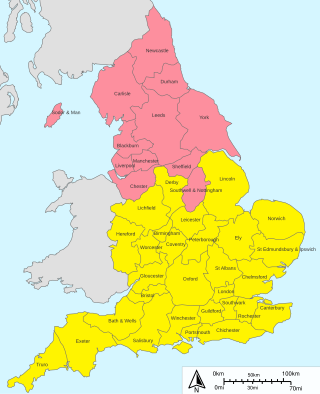
This article traces the historical development of the dioceses and cathedrals of the Church of England. It is customary in England to name each diocese after the city where its cathedral is located. Occasionally, when the bishop's seat has been moved from one city to another, the diocese may retain both names, for example Bath and Wells. More recently, where a cathedral is in a small or little-known city, the diocesan name has been changed to include the name of a nearby larger city: thus the cathedral in Southwell now serves the diocese of Southwell and Nottingham, and Ripon Cathedral was in Ripon and Leeds from 1999 until 2014. Cathedrals, like other churches, are dedicated to a particular saint or holy object, or Christ himself, but are commonly referred to by the name of the city where they stand. A cathedral is, simply, the church where the bishop has his chair or "cathedra".

An enthronement is a ceremony of inauguration, involving a person—usually a monarch or religious leader—being formally seated for the first time upon their throne. Enthronements may also feature as part of a larger coronation rite.
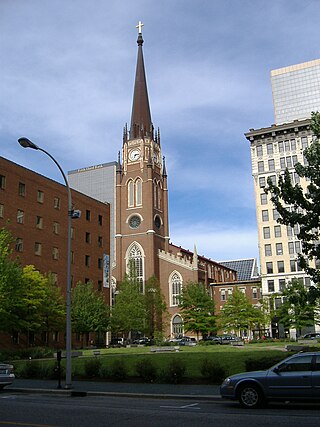
The Cathedral of the Assumption is a Catholic cathedral in Louisville, Kentucky, and the mother church of the Archdiocese of Louisville. It is the seat of Archbishop Shelton J. Fabre, and Martin A. Linebach, vicar general for the archdiocese, serves as rector.
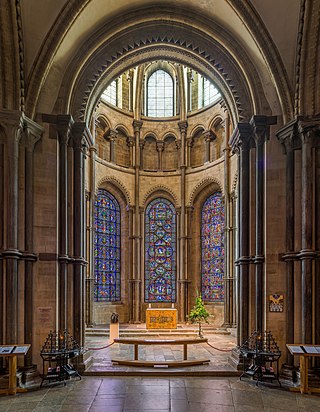
The Corona, Canterbury Cathedral is the east end of Canterbury Cathedral, named after the severed crown of Thomas Becket, whose shrine it was built to contain.

St Augustine’s College in Canterbury, Kent, United Kingdom, was located within the precincts of St Augustine's Abbey about 0.2 miles ESE of Canterbury Cathedral. It served first as a missionary college of the Church of England (1848–1947) and later as the Central College of the Anglican Communion (1952–1967).

The Cathedral Basilica of Christ the King is a Roman Catholic church in Hamilton, Ontario, Canada. The cathedral was consecrated on December 19, 1933. It is the seat of the bishop of the Diocese of Hamilton, and the cathedral of the Diocese of Hamilton. The cathedral contains the cathedra of the bishop, the Most Rev. Douglas Crosby. The cathedral was raised to the status of a minor basilica in February 2013 by Pope Benedict XVI.

St George's Cathedral is the Anglican cathedral in Cape Town, South Africa, and the seat of the Archbishop of Cape Town. St. George's Cathedral is both the metropolitical church of the Anglican Church of Southern Africa and a congregation in the Diocese of Cape Town.

Coronations were previously held in the monarchies of Europe. The United Kingdom is the only monarchy in Europe that still practises coronation. Current European monarchies have either replaced coronations with simpler ceremonies to mark an accession or have never practised coronations. Most monarchies today only require a simple oath to be taken in the presence of the country's legislature.
The Cross of St Augustine is an award of merit in the gift of the Archbishop of Canterbury. It is awarded to members of the Anglican Communion who have made significant contributions to the life of the worldwide Communion, or to a particular autonomous church within Anglicanism. It is also awarded to members of other traditions who have made a conspicuous contribution to ecumenism. It is the second highest international award for service within Anglicanism.
The Lambeth Awards are awarded by the Archbishop of Canterbury. In addition to the Lambeth degrees, there are a number of non-academic awards. Before 2016, these awards consisted of the Lambeth Cross, the Canterbury Cross, and the Cross of St Augustine. In 2016, these awards were expanded with six new awards named after previous Archbishops of Canterbury.